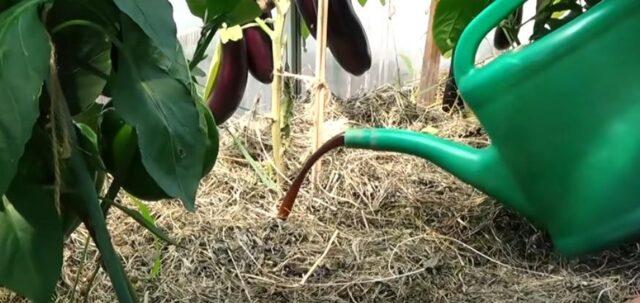Content
Growing eggplants in a greenhouse cannot be called a very simple process, but with a competent approach and preliminary study of certain rules, even inexperienced gardeners can cope with this work. This crop is considered heat-loving and cannot grow in open ground conditions in all regions of Russia, but thanks to greenhouses, it has become possible to obtain a rich harvest even in cold regions.

Judging by the botanical description, eggplant is a berry, not a vegetable.
Greenhouse preparation
Before planting eggplants in the greenhouse, a number of works should be carried out. The first step is to treat and disinfect the room itself, as well as disinfect the soil in which you plan to grow the plant. If this is not done, the plantings may become sick, be attacked by pests, and even die.
Disinfection
Be sure to clean the greenhouse: remove grown weeds, level the area. Next, you need to wash the film and all glass surfaces with soapy water, wipe metal parts with a solution of hot vinegar, and disinfect polycarbonate with potassium permanganate. After this, it is recommended to open the greenhouse and ventilate it well.
There are several methods of disinfection; which one to use is up to the gardener to decide at his own discretion:
- Biological products. Solutions are considered as safe as possible and at the same time effective. Their use not only destroys microbial pathogens, but also increases the nutritional value of the soil.
- Sulfur checker. It can only be used to process greenhouses whose structure is supported by wooden frames. The sulfur released from the bomb is an excellent disinfectant and can penetrate into all corners of the room. After treatment in this way, you should close the greenhouse well and do not enter it for three days, and then ventilate it.
- Bleaching powder. It can be used to spray all surfaces of the greenhouse, as well as equipment.
Soil disinfection
It is also important to disinfect the soil in the greenhouse. If there are plants left in the beds since autumn, they should be removed and the soil should be dug up. You can disinfect the soil from pest larvae and other microorganisms using thermal or chemical methods. The first involves the use of steam equipment or watering the beds with boiling water, the second disinfection with bleach. Lime should be scattered around the entire perimeter of the greenhouse and mixed with the soil using a rake. It is allowed to use formaldehyde for disinfection; it saves eggplants from blackleg.
How to properly grow eggplants in a greenhouse
To grow eggplants in a polycarbonate greenhouse, you need to know many of the subtleties of this process. This culture is considered quite finicky and demanding. It does not like high humidity, does not tolerate temperature changes and shading, and may die due to poor ventilation or improper watering. Therefore, before planting eggplants, you should carefully study the rules of agricultural technology.

Gardeners who know how to grow this plant are considered experts in their field
Soil preparation
Before planting eggplants in a greenhouse, you first need to prepare the soil for planting. If it has already been used before, it is recommended to restore it. To do this, the top layer about 15 cm high needs to be removed, taken outside, combined with organic fertilizers: humus, peat, compost at a ratio of 1:3. The soil should be turned over periodically.
The soil in the greenhouse also needs to be prepared. It is known that eggplants prefer nutritious and light soil rather than tolerate heavy and excessively acidic soil. The correct action when preparing it is to apply organic fertilizers. They are added so that they are located as close as possible to the root system of the plants. It is not recommended to add wood ash.
Sowing time
A favorable time for planting eggplants in a greenhouse is chosen based on the climatic conditions of the region in which the plant is grown. For example, in the southern regions, sowing begins from March until June. In this case, you should focus on frost.Work begins when one and a half to two weeks have passed after the last spring frosts, and the soil has already warmed up to +15 °C.

Eggplants can be planted in warm polycarbonate greenhouses much earlier than in greenhouses
How to properly plant eggplant seedlings in a greenhouse
The plants are quite large spreading bushes, and this is important to consider when planting them. Eggplants should be planted in a greenhouse in a checkerboard pattern or in a row at a distance of at least 0.5 m from each other and 0.6 m between rows. The depth of embedding should be 15 cm. Before planting, holes are first made, humus and ash are placed on the bottom, and filled with two liters of water mixed with potassium permanganate. After the solution is absorbed, the eggplant seedling along with a lump of earth is placed in the center of the hole, sprinkled with soil, compacted, and watered.

Next to eggplants, it is allowed to plant greens, cabbage, peas, and sweet peppers in the greenhouse; proximity to tomatoes should be avoided
Planting eggplant seeds in a greenhouse
If you have a warm polycarbonate greenhouse, the gardener does not need to grow eggplant seedlings at home. In this case, planting material can be sown in greenhouse soil, in order to avoid further planting directly in those places where the crop will grow. It is convenient to do this using a stencil grid with cells 8 by 8 or 6 by 6. Eggplant seeds are placed in the center of the cells to a depth of 5 mm.
If the material for planting was purchased in a specialized store and is of high quality, then it is planted immediately; if not, then it is prepared before carrying out the work.
Features of caring for eggplants in a greenhouse
In order to properly grow eggplants in a greenhouse, it is important to know all the features of caring for them in such conditions. If you do everything according to the instructions, the crop will grow and bear fruit well.

An eggplant harvest can only be obtained if favorable conditions are created for them.
Temperature and lighting
The plant is considered heat-loving and can easily tolerate overheating, but in order to reap a decent harvest, it is advisable to maintain the optimal temperature regime in the greenhouse (from +25 to +28 °C). When the indicator decreases, the eggplant bushes will grow slowly, and their flower buds will go into a dormant state.
When grown in a greenhouse, eggplant loves light and does not get burned even from direct sunlight. The length of the day for him should be no less than 12 and no more than 14 hours. Otherwise, the bushes will stop developing or begin to actively grow green mass. To ensure the required duration of daylight hours, additional lighting is installed in greenhouses in the form of fluorescent, mercury, LED or phytolamps.
Watering
An important condition for growing eggplants in a greenhouse is their regular watering. The culture is moisture-loving; when there is a shortage of water, it sheds its ovaries. The basic rules for its irrigation are:
- use of warm water that has been standing for 24 hours;
- carrying out the procedure exclusively at the root of the plant;
- performing work in the morning.
The first time watering is carried out five days after planting, then once a week. At the moment of fruit formation, they moisten every three days, and if it is hot in the greenhouse, then every day.The amount of water is calculated so that the soil is saturated with it to a depth of 20 cm.

For eggplants, drip irrigation is considered the best method.
Feeding
In order for the plant to bear the maximum amount of fruit, it needs to be fed at least three times a season. To feed the bushes, you can use both organic and mineral compounds, as well as universal preparations for vegetables.
Fertilizers are applied for the first time 20 days after planting seedlings or emergence of seedlings. At the flowering stage, spraying is carried out with boric acid, at the moment of ovary formation - treatment with potassium, when fruits appear - with phosphorus, nitrogen, and wood ash.
To saturate eggplants with nutrients, you can resort to folk recipes, water the plantings with an infusion based on yeast or cut grass.
Mulching
Even when grown in a greenhouse, it is useful to mulch eggplant beds. This method allows you to retain moisture well around the plants, prevents the occurrence of certain diseases, and reduces the frequency of watering. The best mulch is sawdust, straw, peat, dry grass or humus.
Shaping and garter
Those varieties of eggplant that are usually cultivated in a greenhouse are distinguished by the large size of the bushes, which is why they need to be shaped, pinched and tied up. Work begins when the height of the plants reaches 30 cm. Of the stepsons, only the two strongest ones are left, all the others are torn off along with the leaves that create shade for the fruits.Depending on the variety of eggplant, some may require pinching of shoots and some may require cutting off side branches. Also, when caring for a plant in a greenhouse, it is advisable to pollinate the inflorescences yourself with a brush or shake them regularly. Although eggplants are considered self-pollinating, in closed ground conditions in the absence of wind the process can be difficult.
Due to the fact that the fruits of the plant are quite heavy, it is recommended to tie the bushes in several places. It is better to choose metal stakes or trellises as support.
Protection from diseases and pests
Even if you grow eggplants in a greenhouse, you should not forget about protecting them from external factors. If not properly cared for, they can become sick or be attacked by pests. Common crop diseases are late blight, anthracnose, mosaic, black or gray rot. The insects that most often attack eggplants are slugs, aphids, whiteflies, Colorado potato beetles, and spider mites.
To combat diseases, gardeners use various chemicals such as Fitosporin or Zircon. To destroy pests, biological products are used, for example, Strela. Sometimes, to get rid of unwanted guests that appear in a greenhouse, folk methods are sufficient: spraying with garlic solution, infusion based on tomato tops, or dusting with ash.
Harvest and storage
If properly cared for, literally a month after germination in the greenhouse, it will be possible to harvest the first harvest of eggplants. It is recommended to remove the fruits with pruning shears, along with the stalk in a slightly unripe state.You should not wait for them to grow to large sizes, since the larger the fruit becomes, the worse its taste.
The harvest can be stored for about four weeks in the basement, cellar or refrigerator. It is also possible to freeze the fruits.

Before being sent for storage, eggplants are wrapped in paper or placed in bags with ventilation holes.
Conclusion
Growing eggplants in a greenhouse may seem like a very difficult task only at first glance. If you follow all the recommendations of experienced gardeners and choose the right plant varieties, you can fully count on success in this matter. Thanks to the advent of greenhouses and greenhouses, eggplants can be grown even when living in areas with harsh climatic conditions.








